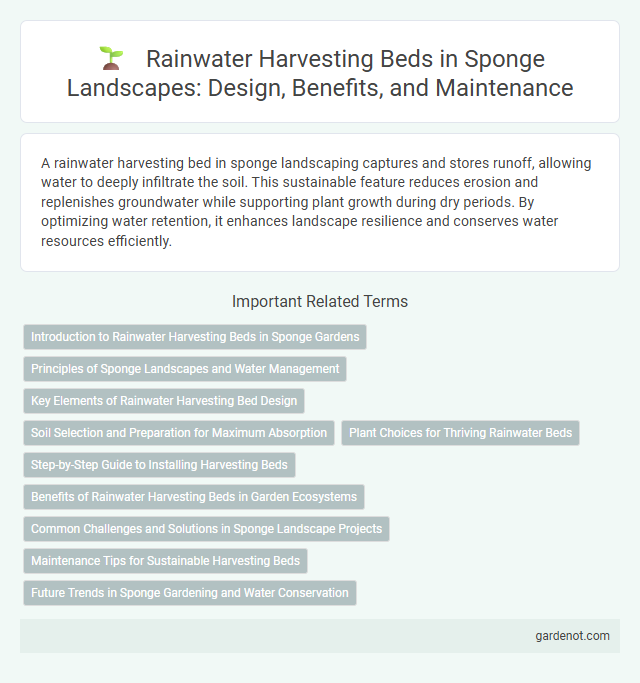A rainwater harvesting bed in sponge landscaping captures and stores runoff, allowing water to deeply infiltrate the soil. This sustainable feature reduces erosion and replenishes groundwater while supporting plant growth during dry periods. By optimizing water retention, it enhances landscape resilience and conserves water resources efficiently.
Introduction to Rainwater Harvesting Beds in Sponge Gardens
Rainwater harvesting beds in sponge gardens are designed to capture, store, and infiltrate rainwater, enhancing groundwater recharge and reducing surface runoff. These beds are typically filled with porous materials like sand, gravel, and organic matter that facilitate water absorption and prevent erosion. Integrating rainwater harvesting beds helps maintain soil moisture, supports plant health, and mitigates urban flooding.
Principles of Sponge Landscapes and Water Management
Rainwater harvesting beds are designed to capture, infiltrate, and store stormwater using permeable soils and vegetation, aligning with the core principles of sponge landscapes that emphasize water retention and gradual release. These systems enhance groundwater recharge while reducing surface runoff and erosion, contributing to sustainable urban water management. Effective integration of rainwater harvesting beds supports resilience against flooding and maintains ecological balance by mimicking natural hydrological processes.
Key Elements of Rainwater Harvesting Bed Design
Rainwater harvesting bed design incorporates key elements such as permeable soil layers, strategically placed collection channels, and contouring to maximize water infiltration and retention. Incorporating organic mulch and native vegetation enhances soil moisture conservation and reduces runoff. Proper slope gradient and sediment traps prevent erosion, ensuring sustainable water harvesting in sponge landscapes.
Soil Selection and Preparation for Maximum Absorption
Selecting loamy or sandy soil with high organic matter enhances rainwater absorption in sponge landscape rainwater harvesting beds. Proper soil preparation, including deep tilling and adding compost, improves permeability and water retention capacity. Well-prepared soil structure reduces runoff and maximizes infiltration, promoting effective rainwater harvesting.
Plant Choices for Thriving Rainwater Beds
Selecting native, drought-tolerant plants such as sedges, rushes, and wildflowers enhances the efficiency of rainwater harvesting beds by promoting water absorption and reducing runoff. Deep-rooted species like switchgrass and blue flag iris improve soil structure and filtration, supporting sustained moisture retention. Incorporating diverse plant varieties ensures ecological balance, minimizes erosion, and maximizes the functionality of sponge landscapes.
Step-by-Step Guide to Installing Harvesting Beds
Creating a rainwater harvesting bed begins with selecting a low-lying area to efficiently capture runoff water. Excavate the site to a depth of 12-18 inches and shape it with gentle slopes, then line the base with organic matter or mulch to improve water retention and soil fertility. Install overflow outlets or drainage channels to prevent waterlogging, and plant native vegetation to stabilize the soil while enhancing the water absorption capacity.
Benefits of Rainwater Harvesting Beds in Garden Ecosystems
Rainwater harvesting beds enhance garden ecosystems by efficiently capturing and storing rainfall, reducing water runoff and soil erosion while promoting groundwater recharge. These beds improve soil moisture retention, supporting plant health and biodiversity by creating a more resilient microhabitat. Integrating rainwater harvesting beds in garden design contributes to sustainable water management and reduces dependence on external irrigation sources.
Common Challenges and Solutions in Sponge Landscape Projects
Rainwater harvesting beds in sponge landscape projects often face challenges such as soil erosion, clogging of inlets, and inadequate vegetation cover, which reduce water infiltration efficiency. Implementing permeable soil mixtures, routine maintenance to clear debris, and selecting drought-resistant native plants can significantly enhance bed performance and longevity. Proper design adjustments like graded slopes and sediment traps further mitigate erosion and sediment buildup, ensuring sustained functionality.
Maintenance Tips for Sustainable Harvesting Beds
Regular inspection and removal of debris in rainwater harvesting beds ensure optimal water absorption and prevent clogging. Incorporating native plants with deep root systems helps maintain soil structure and enhances filtration efficiency. Periodic checks of inlet and outlet structures avoid erosion and support sustainable water retention in the sponge landscape.
Future Trends in Sponge Gardening and Water Conservation
Rainwater harvesting beds are emerging as a critical innovation in sponge gardening, enhancing water retention and reducing urban runoff by capturing and storing precipitation efficiently. Advanced materials and smart sensors integrated into these beds optimize absorption rates and promote sustainable water cycling within landscapes. Future trends emphasize the integration of eco-friendly designs and data-driven irrigation management to maximize water conservation and support resilient, drought-tolerant ecosystems.
Rainwater harvesting bed Infographic

 gardenot.com
gardenot.com